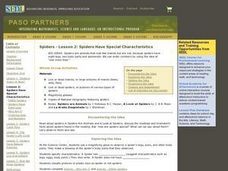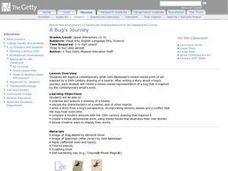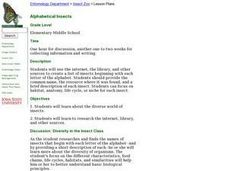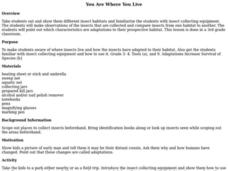Curated OER
Insect or Arachnid?
Learners compare and contrast the characteristics of insects and arachnids through research, observation, and discussion. They write accurate statements describing insect and arachnid life cycles and anatomies. Afterward, they listen as...
Curated OER
Insects A-Z!
Alphabet insects! Who has ever heard of such a thing? Get ready because your class is going to research insects that start with a specific letter of the alphabet. In small groups, they'll use the Internet and reference texts to locate...
Curated OER
Imaginary Insect Zoo
Students create imaginary insects that contain essential characteristics of an insect, such as six legs and three body parts. In this Science/Arts lesson, students distinguish between an insect and non-insect. Students create their...
Curated OER
Insects
Students study the characteristics and basic needs of insects. They compare and describe similarities among insects. They examine the body structure, covering, and movement of insects and also, examine insect life cycles in this unit of...
Curated OER
My Life As An Insect In Namib
Young scholars examine the harsh living environment of the Namib Desert. They watch and discuss a video, record the types of insects observed in the video, record information about insects and animal adaptations in their science...
Curated OER
Imaginary Insect Zoo
Students construct imaginary insects. In this insect lesson plan, students will discover the anatomy of their favorite insect and apply it to their own creation. Student will write a description of their model, and put the insect models...
Curated OER
Insects Are Helpful!
Students see that insects do lots good and are very valuable to humans and nature. This is part of an ongoing effort to dispel fears of insects. They rotate through a series of centers that have examples of how insects contribute to our...
Curated OER
I Wish I Were a Butterfly
Students inquire about biology by reading a children's book in class. For this insect lesson, students read the story "I Wish I Were a Butterfly" and identify the unique characteristics of butterflies and other insects. Students...
Curated OER
Skeeterville
Students explore insect life by participating in a role-playing activity. In this mosquito life instructional activity, students listen to a role-play scenario in which they must protect a town from mosquitoes by creating a field guide...
Curated OER
Bug's Eye View
Investigate the life of bugs and how they interact with the environment in this integrated science and language arts instructional activity. Young scientists construct mini environments in cages in order to make observations. This data...
American Museum of Natural History
Wonderful World of Wasps
Shockingly, wasps sometimes challenge lions as the king of predators! Learners explore the life of a wasp in an interactive online lesson. They read about the characteristics of wasps and then complete activities to learn about their lives.
Curated OER
Spiders Have Special Characteristics
Students state reasons why spiders are grouped in specific categories, including what distinguishes a spider from an insect. They report on their observations of the spiders. They illustrate their report with drawings in their journals.
Curated OER
A Bug's Journey
Students examine the artwork of John Baldessari that was inspired by a 16th century drawing of a beetle. They analyze a drawing of a beetle, discuss the insect's characteristics, and write a story from the perspective of a bug. Also,...
Curated OER
Buzzing is BEE-lieving
Students investigate insects. In this insect lesson, students explore various insect models and identify the characteristics of each. Students observe insects outside and tally how many insects they observe.
Curated OER
Crickets Guided Discovery
Sixth graders investigate insect anatomy by analyzing a live cricket. In this insect science lesson, 6th graders discuss their knowledge of insects and describe their characteristics from memory. Students observe live...
Curated OER
Insects at Home
Fourth graders search their house and surrounding neighborhood for insects. They complete a chart that help students organize the name, physical description, location found, and any unique characteristics of the insect.
Curated OER
Creative Insects
Third graders examine insects that are common around the school. They write a creative story about being an insect for a day and include scientific data that they learned.
Curated OER
Alphabetical Insects
Students research using the internet, the library, and other sources to create a list of insects beginning with each letter of the alphabet. They provide the common name, the resource where it was found, and a brief description of each...
Curated OER
Insects
Students work in groups to investigate the concept of insects. They participate in a variety of activities that include the gathering of samples and making observations like identifying different body parts. The lesson integrates...
Curated OER
Yuckiest Site on the Internet
Learners investigate the worm and the cockroach. In this organisms lesson, students visit suggested websites to identify the characteristics of worms and cockroaches. Learners dissect a worm and observe a live cockroach. Students...
Curated OER
Plan, Do, Review...What's Bugging You?
Young scholars explore insects through literacy, In this literacy lesson, students discover the characteristics of ladybugs and gain information from the text, "The Grouchy Ladybug". Young scholars go on a "bug hunt".
Curated OER
You Are Where You Live
Third graders observe insects in a number of habitats. They recognize which insect characteristics are adaptations to their habitats.
Curated OER
Parasite Development and Life Cycle
If you are new to teaching agriculture classes, this outline may be helpful when you are preparing a lecture on parasites in livestock. In addition to lecturing on this topic, the lesson plan suggests that learners research the life...
Curated OER
Insects
Students, through books, videos, and readings, explore characteristics of insects. In groups, they choose an insect to research. Students discover their insect's diet, how they move, and where they live. Afterwards, they use the facts...























